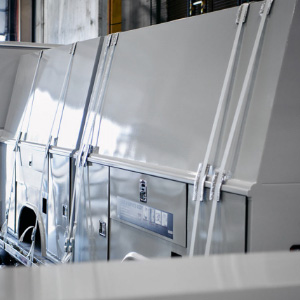Becoming an effective fleet manager means making your vehicles work together as efficiently and profitably as possible. You must account for the safety of your trucks and drivers, maintain the trucks in your fleet, ensure proper communications with employees and define clear goals for your team. To get the most from your fleet, create a plan to tackle each of these everyday tasks. Identify your fleet’s requirements in each task and how you will address them. With these fleet truck management tips in mind, you can increase efficiency much more quickly than without an approach to improvement.
Fleet Safety
The safety of your fleet and its drivers should always rank as your top concern among fleet management principles. Accidents cause loss of worker time as well as the vehicle. Safety can prevent accidents while reducing your losses.
1. Train Drivers in Safety
First, you must choose your drivers carefully. When hiring, select drivers with proven safety records. A safe driving record will only give a part of the picture, though. The AAA Foundation for Traffic Safety found 87% of drivers engaged in unsafe habits while on the road, including:
- Speeding
- Operating a vehicle while impaired
- Running red lights
- Driving while distracted
- Failing to wear a seat belt
- Being drowsy behind the wheel
The drivers may not have received tickets or gotten into accidents from these behaviors, which is why you should continue to train employees with excellent records in safe driving habits.
Training your employees to avoid these dangerous habits can help prevent problems that could cause accidents, especially if driving is only a part of their job. For example, when you have HVAC techs or plumbers driving your fleet vehicles, they may not realize the impact of their driving habits. You need to train them to be especially careful when behind the wheel of a company truck.
Schedule regular training and updates throughout the year. First, have new hires go through a safe-driver course to ensure they know your company’s standards for operating vehicles. Later, keep established drivers updated on practices with semi-annual or annual seminars. Schedule retraining for workers who get tickets or get into accidents to reorient them with safe practices. Continuing safe driver education will prevent your workers from forgetting the methods that can prevent accidents.
2. Create Written Policies
Just telling your drivers about your policies will not be enough to establish effective fleet management. Put everything into writing and have your workers sign that they have received the information and understand it. Keep a copy of driving policies posted near the fleet for employees to reference when needed.
During training sessions, reference the procedures, so workers have heard and seen the information. If you make any updates to the policies, always inform your drivers. They will want to know about any policy changes, especially those that affect their driving.
3. Monitor Driver Behavior
While you cannot be in the cab of every one of your fleet’s trucks, you can still monitor the driving habits of all your fleet employees. Installing monitoring software into your fleet vehicles lets you see how the drivers perform on the road. Aggressive driving, such as speeding and hard braking, can take a toll on the longevity of your fleet vehicles while increasing the chances of an accident.
Take a baseline reading over a month to determine the drivers’ standard behaviors. Discuss changes individually with drivers who regularly engage in dangerous driving habits. Stress that 94% of accidents occur from poor driver choices rather than equipment failure, and unless a driver corrects their bad habits, they cannot drive for your fleet.
Keeping tabs on your drivers’ habits and training them to be safe can help reduce accidents, save you money and protect your employees from harm while behind the wheels of your fleet’s trucks.
Fleet Maintenance
Another major aspect of vehicle fleet management is maintaining all the trucks you have. Conducting preventative service and repairs can help you avoid time-stealing breakdowns when your drivers are on the road. Regular maintenance can also improve your vehicles’ resale value for when you plan future upgrades of your fleet.
1. Use Driver Checklists
Assign checklists to drivers so they can conduct quick inspections before they check out a fleet vehicle. These checklists should include checking the appearance of the truck and tire pressure at least. Poorly maintained tire pressure could impact fuel efficiency, tire life and vehicle handling. With extreme temperatures, the tire pressure can change, making regular checks critical.
Put any vehicles that drivers flag for poor performance or inspection problems into maintenance immediately. Do not allow a problem vehicle to stay on the road. Doing so will only increase the chances of a malfunction.
2. Track Repairs and Service
Don’t service vehicles on a whim. Keep track of all vehicle mileage readings and maintenance schedules. Also, list out any warranties you have for trucks in your fleet. Having a single place in your records to refer to warranty information will make it easier to determine if your vehicle repairs have warranty coverage or not. With regular tracking, you can save thousands of dollars by not conducting repairs your vehicles’ warranties will pay for.
Keeping track of any services on the vehicles also prevents you from doing maintenance too often. Knowing exactly when your trucks need service will also prevent problems caused by going too long between oil changes and similar chores.
3. Plan for Future Sales and Purchases
Tracking your fleet’s maintenance will make it easier to establish good care of the trucks when you need to sell them. Additionally, well-maintained vehicles can earn you more money when you resell them. If you regularly change out the vehicles in your fleet, keep an eye toward future selling of older vehicles.
Purchase trucks for your fleet that have low maintenance requirements and good reliability records. You will spend less on making repairs to such vehicles. Also, buy trucks that can handle the tasks your fleet performs. If your trucks cannot handle the cargo loads and add-ons like a hauler body or service bodies, you need to rethink your vehicle purchases. Even choosing the minimally operational chassis for your work can lead to a reduced lifespan from constantly working the truck to its maximum capabilities.
4. Reduce Fuel Consumption
Consider fuel to be a maintenance cost that lasts the life of the vehicle. Reducing fuel consumption lowers your costs for gasoline or diesel the entire time you use the trucks. When your fleet has heavy-duty trucks that carry a lot of cargo, you start from relatively lower fuel efficiency values compared to a fleet with hybrid sedans. Despite this disadvantage, you can still improve fuel economy in all your fleet vehicles.
Purchase the most fuel-efficient trucks you can find that fulfill your fleet’s needs. Diesel trucks often have better fuel economy, but they cost much more than gasoline vehicles. You will need to decide if your fleet’s use of the trucks justifies the extra cost of purchasing diesel-fueled vehicles. You can also find highly efficient gasoline vehicles with high fuel efficiency ratings. If your fleet includes sedans or light-duty trucks, consider gasoline vehicles for these.
Regardless of the fuel type used, encourage driving behaviors that will not negatively impact fuel economy. If your drivers paid attention to the safety course, they will already engage in these behaviors of not speeding and not accelerating quickly from a stop.
If your fleet vehicles carry cargo, don’t carry more than you need. Too much cargo in the bed or the cab of a truck, weighs down the vehicle, reducing its fuel economy.
Lowering the amount of fuel your fleet trucks need will save you money over the long run and make your fleet more efficient.
Fleet Communication
Communicating with your drivers is imperative to ensure they understand your expectations. Drivers may have more contact with their dispatcher than with you, their fleet manager. You need to ensure every contact with the drivers creates a meaningful conversation to allow two-way communication.
1. Ask for Feedback
Regularly ask your drivers for feedback about company operations, your work and their productivity. If you make a habit of asking them for their input and take their suggestions seriously, they will feel more confident in giving you their opinions.
Your drivers are on the front lines of using the vehicles in your fleet. They have the best vantage points to see how well the trucks run and if you can make any changes in maintenance, service or vehicle selection. The drivers may give you ideas you would never have considered if you didn’t ask for their feedback.
2. Develop Superior Communication Abilities
Part of communicating with your team means you need to have excellent communication skills. You need to convey your expectations and desires in a manner that all your employees can understand. Communication skills also include the ability to talk to the managers in the company above you when you need to discuss policy changes or fleet goals.
If you need to take courses in communication or get pointers from others who can talk to people, do so. Better communication skills will make you a more effective fleet manager.
3. Create a Culture of Communication
As you work to improve your ability to communicate, cultivate a team that feels free to talk among themselves about what they want from the company. Encourage discussion during safety classes and offer multiple ways for workers to communicate their expectations, questions and concerns with you. Have an open-door policy to admit anyone who wants to talk to you. Also, give workers the chance to anonymously submit concerns. For sensitive matters, workers may feel more comfortable divulging information if they don’t have their names attached.
Fleet Goals
Don’t run your fleet on a day-to-day basis. Your operations and profits will stagnate. Instead, know what you want your fleet to look like in the future. Do you want to increase in size or operating locations? Do you want more vehicles? Do you wish you could invest in more technology? The answers to questions such as these will help you in your goal-setting process. When you have a goal, you will know what you need to do to make your fleet as efficient as possible.
1. Establish a Master Plan
For your fleet to be most effective, you need to know what you will want for it in the future. The best way to accomplish this trajectory is by developing a master plan. Use this plan when setting short-term and long-term goals for your fleet. With a complete picture in mind, you will know which parts of your fleet you most need to improve on.
2. Outline Short-Term Goals
Set clear goals at the beginning of the year and revisit them regularly. These goals may be quarterly, monthly or annual goals, but each aspiration needs to be a part of how your company will get closer to its ideal state in your master plan.
3. Communicate Goals With Employees
Communicate your goals for the fleet and company with your workers. You need the drivers to know about all your fleet goals, but especially the ones on which they have a direct effect. For example, if one of your goals is to cut costs by reducing fuel mileage, you need to train your drivers to achieve that goal.
Consider incentivizing meeting goals by offering prizes or bonuses to your drivers. When the drivers have rewards to work toward, they will be more likely to help you in reaching those milestones.
4. Research and Adopt Technology
Your fleet may need help to reach its goals, especially long-term ones, and technology might be the solution. For example, if you want to help your drivers be safer behind the wheel, invest in tracking software and hardware to monitor their behaviors. Use software programs to keep tabs on when your vehicles receive service or repairs. Such technological innovations can make reaching your fleet’s goals easier.
Don’t neglect new technology, either. You can incorporate phone apps and more into your business to improve communications, reduce paperwork and keep your vehicles on the road. Do your research to find which of the latest devices will improve your fleet’s operations and help you meet your goals.
Fleet Customization
To effectively operate and manage your fleet of vehicles, you need your trucks to be able to handle the jobs you need them to do. Customizing your vehicles with service bodies and other additions can improve the productivity of your fleet’s trucks. We work with fleet owners with HVAC companies, utilities, construction, landscaping, telecom and other industries to customize their trucks to their organization’s specific needs.
Find out more about our fleet solutions and how you can get more from your vehicles by contacting us at Reading Body. We’re here to provide you with the body options your fleet needs to be as productive and profitable as possible.




